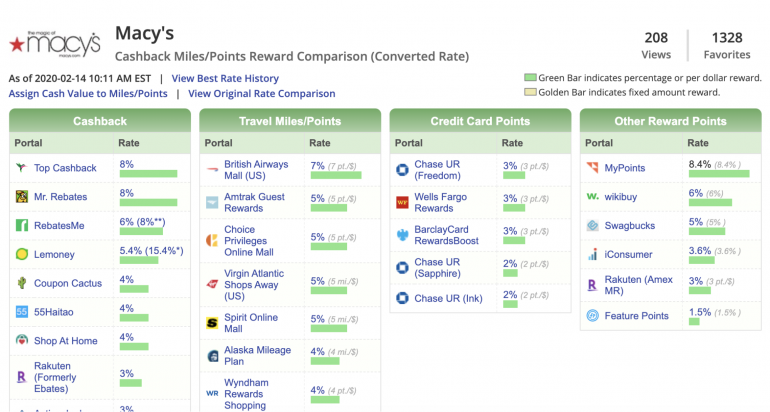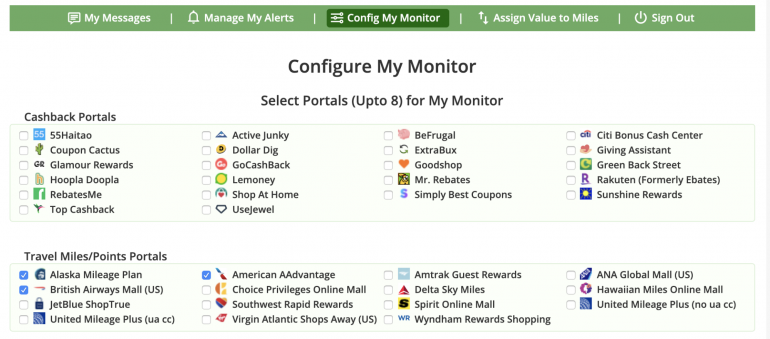Cashback Monitor Review: Impressive Performance, Clunky Design

Many or all of the products on this page are from partners who compensate us when you click to or take an action on their website, but this does not influence our evaluations or ratings. Our opinions are our own.
Those who want to stretch their spending rewards to the limit use “shopping portals,” which stack the normal rewards earned with credit cards with extra bonus points at some retailers.
However, those overwhelmed by shopping portals (including myself) often forgo this ninth circle of reward maximization. Those extra hundred Chase points often just aren’t worth the headache.
That’s the problem Cashback Monitor aims to solve. The platform tracks reward rates at tons of shopping portals, placing them in easy-to-digest, customizable tables. At least, that’s the aim.
Should you use Cashback Monitor to take your shopping portal game to the next level, or get your game started in the first place? Let’s dive in.
Shopping portal primer
Here’s how shopping portals (generally) work:
They receive affiliate revenue for sales made through their platforms.
They pass some of that revenue on to you in the form of cash or points back.
They regularly run promotions (usually aligned with higher affiliate rates) for certain products or services.
So Cashback Monitor is like a meta-middleman data management system. To be honest, you don’t need to know how the sausage is made in order to get the benefit.
Cashback Monitor basics
The site is free to join and use. There are several ways to use the site, but using the “search” function is the simplest. Let’s say you’re looking to buy from Macy’s and want to find the best rewards option. Just type “Macy’s” into the search bar and you’ll arrive at a page like this:

Here Cashback Monitor breaks rewards out by type in the four columns, each sorted by reward payout. Note that the currencies are not consistent: The values in the leftmost column represent actual cash back in dollars, while the rest are estimated values based on reward points and miles.
Do you value some points higher than the baseline estimate of one cent per point? Then Cashback Monitor has a cool feature for you …
Customization
Creating an account lets you customize and personalize Cashback Monitor’s interface. For example, you can assign your own values to points and miles. Here I’ve entered Nerdwallet’s valuations where they overlap with those available on Cashback Monitor:

After saving, these values will now appear throughout the site, affecting how offers rank. For example, an offer of 5 Southwest points per dollar spent will rank higher than one that offers 5 Alaska miles per dollar spent, since I have “told” Cashback Monitor to value the former at 1.4 cents and the latter at 0.9 cent each.
You can customize the platform further in the “configure my monitor” setting:

This lets you choose the reward programs you’re actually interested in (or not). The programs you select will appear in, you guessed it, your monitor:

This screen provides a handy at-a-glance way to find and maximize your existing rewards programs.
Usability
The nuts and bolts of Cashback Monitor’s interface work great. It’s not a terribly complex data-management problem they're solving, but the tables and dashboards certainly provide all the information you need to make an informed choice.
However, the way they organize and systematize this information leaves much to be desired. Let’s take the example of the “My Monitor” customization described above. Here’s the menu layout:

Nope, the personalization tab isn’t up by my name and photo, where you might expect. It’s underneath the NerdWallet ad. Further down. Nope, one more menu down.

I’m being cheeky, but this burdensome UX is one of the major drawbacks of using Cashback Monitor. Its Craigslist-era design sensibilities have a certain retro appeal to those of us who came of age in the late 90s. For everyone else, it’s a drag.
Who should use it?
In my view, there are two types of rewards-chasers who would benefit from using this platform:
Experts who know the terrain already and want a customizable tool for streamlining their own system.
Those who want to maximize their major purchases but don’t want to spend tons of time tracking and comparing multiple shopping portals.
Beginners to the points and miles game are probably wise to steer clear of Cashback Monitor and its expert-focused interface, unless they really want to spend an extra few minutes figuring out how to earn an extra hundred points or miles.
How to maximize your rewards
You want a travel credit card that prioritizes what’s important to you. Here are some of the best travel credit cards of 2025:
Flexibility, point transfers and a large bonus: Chase Sapphire Preferred® Card
No annual fee: Wells Fargo Autograph® Card
Flat-rate travel rewards: Capital One Venture Rewards Credit Card
Bonus travel rewards and high-end perks: Chase Sapphire Reserve®
Luxury perks: The Platinum Card® from American Express
Business travelers: Ink Business Preferred® Credit Card
Planning a trip? Check out these articles for more inspiration and advice: Find the best travel credit card for you Use ‘virtual malls’ to rack up airline points on your next hotel How to get started with frequent flyer programs
Chase Sapphire Preferred® Card
Travel
Dining
🔥 Huge highest-ever bonus on NerdWallet's 2025 Best All-Purpose Travel Rewards Card is back. Don't miss your rare chance to: Earn 100,000 points when you spend $5,000 on purchases in the first three months. That's worth at least $1,250 toward travel booked through Chase.


